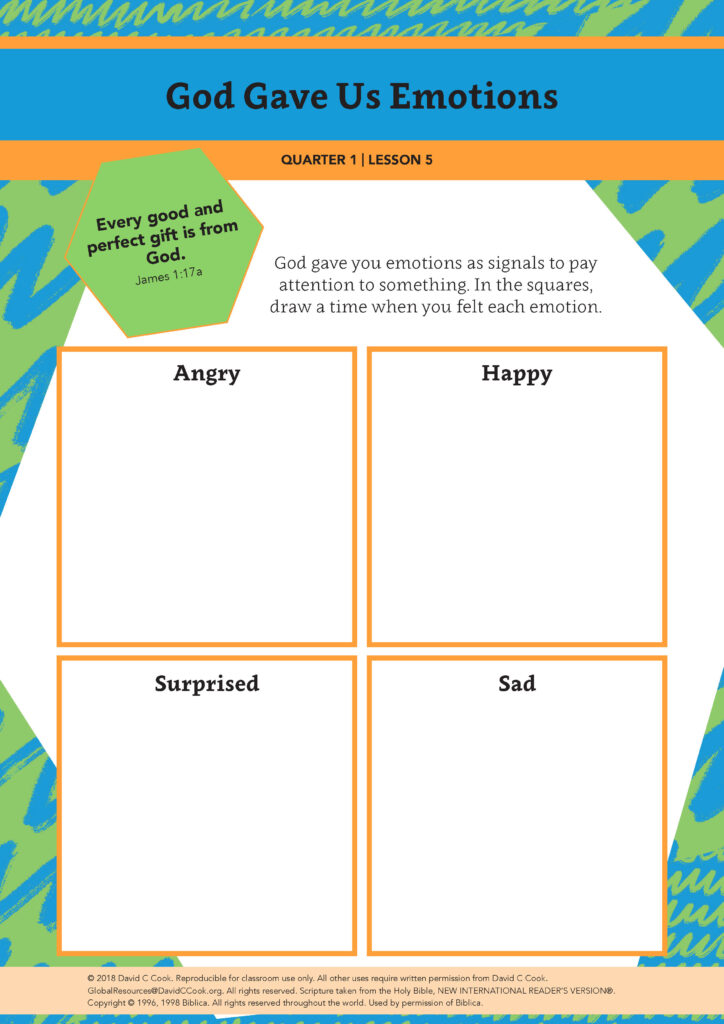During the lesson, the information for you to know is written in regular type, and what we suggest speaking or reading aloud to children is in bold. All resources for this lesson, including the Teacher Guide, Student Page, Family Connection Card, and other resources can be downloaded in a ZIP file by clicking on the following link:
In some lessons you will find "resource articles." These are articles written by experts from around the world to help equip you for your work with children and adolescents. Share them with parents or guardians if you consider it appropriate.
Unit Introduction: In the next 4 lessons, the children will learn about emotions and how to deal with them in healthy ways. Having lots of different emotions is a natural part of life. Emotions are not right or wrong—but the ways we choose to express them can be healthy or harmful.
Emotions are signals that we need to pay attention to something. Unfortunately, children often do not know how to recognize their emotions or what to do with them. Children often respond to difficult emotions in 2 ways. Either they ignore the feeling and bury it deep inside or they misbehave. If children do not know how to handle strong emotions such as sadness or anger, they may try to bury these emotions instead of expressing them. This can cause them to withdraw, hide, feel depressed, or become unresponsive. Other children may express feelings by “acting out.” They may react physically by doing things such as screaming, hitting, or rocking back and forth. Children may respond in different ways at different times.
Children who have not developed in emotionally healthy ways often act much younger than their physical ages. Being comfortable with emotions and finding healthy ways to express them are important steps toward healthy living.
There is a time to weep. And there’s a time to laugh. There is a time to be sad. And there’s a time to dance.
Ecclesiastes 3:4
Sometimes we feel it is wrong to experience certain emotions such as anger or depression. But God gave us all of our emotions—grief and laughter, sadness and joy, and everything in between. Emotions themselves are not right or wrong. They are a signal to us that something is affecting us. If we do not deal with our difficult emotions, we can remain in an unhealthy place. If we do not ask for God’s help in dealing with our negative emotions, we often react in ways that hurt others or ourselves.
Throughout your life, you will experience many different emotions. It is important to recognize them and ask yourself what is causing them. For example, if you are angry, why are you angry? Is it because you are afraid or worried? As you recognize what you are feeling, you can surrender those emotions to God so that you do not sin against Him, others, or yourself. This week, pay attention to your emotions. Thank God that you can experience the heights of joy and the depths of grief. Together they weave into the abundant life God has promised to you!
In the next few weeks, the children will learn about emotions and how to deal with them in healthy ways. Feelings act as signals that we need to pay attention to something. If possible, share the Resource Article on Emotional Intelligence with the children’s families.
Teacher Tip: If possible, email or text the Family Connection Card to the families of your students.
Greet the children as they come into class. Try to greet them by name if you can. If you are still trying to learn their names, come up with something to help you remember, such as noticing a child’s smile and calling her “Sarah smiles.” Knowing the children’s names will help them feel valued and noticed.
Today we will begin to learn about our emotions.
An emotion is a reaction to something that affects your mood and thoughts. If it is strong, it can even affect your body! God gave us emotions. They are not good or bad. But how you choose to act based on those emotions can be healthy or harmful.
Allow 1–2 children to respond.
I will tell you a story now. When you hear an emotion in the story, show it on your face.
Show the children how to do this. Read the following sentence and show an angry face after you read it: “He hit me and stole all my money!” The feelings in the story are underlined.
Here is our story. Once, there were 3 pigs who decided they wanted to build their own houses. The first pig met someone who was selling straw. The pig decided this would be an easy house to build since the straw was not too heavy. The pig was sad because every time he finished building a wall, the wind would blow it down. Finally, the pig was happy because the house was finished, and he went inside to celebrate.
There was a big wolf who lived nearby, and he decided he wanted to eat pig for dinner. He was excited when he saw the straw house. He knocked on the door. The first pig was surprised that someone was at his door. When he peeked out a window to see who was there, he saw the wolf. Because the pig was scared, he climbed out the window and went to find his brother. When the wolf knocked again, the whole house fell down!
If you need to, remind the children to show the emotions on their faces.
The first pig found his brother busy working hard to build his house out of sticks. He was sad that his straw house had been so weak. This house of sticks would certainly be stronger than the straw house! The 2 pigs finished the house and happily went inside to celebrate. They were dancing a silly dance when the wolf showed up at this house too! The wolf was angry that the first pig had escaped. Now he thought he would have 2 pigs to eat instead of only 1. But the 2 pigs ran away to find their brother before the wolf could eat them.
The last pig was busy working hard on his house made out of bricks. He was tired from working hard in the hot sun. When his brothers came, they joined him, and soon the house was finished. The 3 brothers went inside to relax. When they heard a knock at the door, they were scared that it was the hungry wolf again. And it was!
The brothers told the wolf to go away! Even though the wolf tried to get into the house, he could not. He went away sad and hungry.
Good job showing lots of different emotions during the story! In this story, the characters felt things such as happiness and fear, surprise, and anger.
If you have ever felt some of these emotions, raise your hand.
All of the children should raise their hands since everyone has these emotions at some time.
Let’s learn some more about our emotions now.
Listen to this verse we learned a few weeks ago:
Read the verse directly from your Bible.
So God created human beings in his own likeness. He created them to be like himself. He created them as male and female.
Genesis 1:27
God created each person to be like Him. God has emotions. We also have emotions because we are made to be like Him. The Bible tells us that God feels happiness, anger, sadness, grief, hatred, and love. Because we are made to be like Him, we also feel these same things.
Emotions are not right or wrong. But our response, how we act because of what we are feeling, can be right or wrong. Emotions are like signals to us. They tell us to stop, slow down, or pay attention to something or someone. God gave us emotions as a gift. The Bible says:
Every good and perfect gift is from God.
James 1:17a
It is a gift to feel emotions, but this does not mean all of our emotions make us feel good. If you enjoy feeling happy or excited, raise your hand. That is good! God wants us to feel those things. If you enjoy feeling sad or angry, raise your hand. No one likes to feel sad or angry? That is normal, but it is important to pay attention to these difficult feelings when they come. They act as signals that we need to pay attention to whatever is causing those feelings.
Let’s get into groups of 3. I will read some situations to you. For each situation, your group will decide which emotion the person is feeling and why.
Give the children a minute to form groups of 3. After you read each situation, give the groups about a minute to talk about what feeling the child is having and why. Ask 2–3 different groups to share their answers after each situation.
Situation 1: A boy comes to school without any shoes. Everyone else has shoes. How does this boy feel and why?
Situation 2: A girl has 2 friends who always argue with each other. The friends tell the girl that she must choose which of them she wants to be friends with. How does this girl feel and why?
Situation 3: An older brother does not do his chores but forces his younger brother to do all the chores for both of them. How does this young brother feel and why?
You did a good job deciding what the people were feeling in these situations.
Have the children stay in their groups of 3. Tell the children that you will call out an emotion. In their groups, the children will share a time when they experienced that emotion. If they cannot think of anything or they do not feel comfortable sharing, they can say, “Pass.” As the groups are sharing their emotions, remind them to be kind to one another. Do this activity for about 5 minutes, calling out a new emotion each minute. After the activity, ask the children to be quiet.
You all did a very good job sharing your emotions with your groups. Sometimes it can be difficult to share strong emotions. But it is important to learn to recognize what you are feeling and why. It will help you to respond in good ways, even when your emotions are very strong. We will learn more about this in the next few weeks.
Optional: If you are using the Student Pages, have the children draw a picture of a time when they experienced each emotion.

Show the Memory Verse poster if possible. Read the verse directly from your Bible.
Our memory verse is:
Be joyful with those who are joyful. Be sad with those who are sad.
Romans 12:15

Create a rhythm to go with the memory verse. Use the same rhythm each week as you help the children memorize this verse. Encourage students to clap or pat their hands on a surface to help keep the rhythm. They may also choose to dance as they say the words. Repeat the verse and rhythm with the children at least 3 times.
End class by speaking this blessing, based on James 1:17a and Genesis 1:27, over the children.
Blessing: God made you to be like Him, so He gave you emotions. May these emotions be signs to help you pay attention to what you are feeling. These emotions are a good gift from God!
If you have time, share this song with your children to celebrate how great God is! Use this as your worship theme this quarter.
Life on Life ©2020 David C Cook. Reproducible for home or classroom use only. All other uses require written permission from David C Cook [email protected]. All rights reserved.